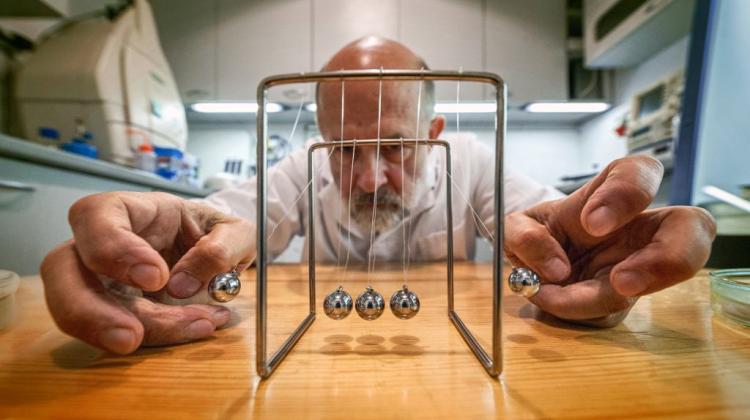Small droplets surprise: they evaporate slower than they "should"

It would seem that we know all there is to know about evaporation. Meanwhile, there\'s another surprise: small droplets turn out to be marauders and evaporate more slowly than their larger counterparts, physicists from the Warsaw institutes of the Polish Academy of Sciences found.
This applies not only to water but also to other liquids: it turns out that very small droplets evaporate more slowly than the current models of the phenomenon predict! Researchers from the Institute of Physical Chemistry of the Polish Academy of Sciences in Warsaw, in cooperation with the Institute of Physics of the Polish Academy of Sciences, used theoretical analyses, computer simulations and experiments to describe the evaporation of micro- and nanometer-sized droplets (that is, billionth of a meter). The Institute of Physics PAS informed about their research in a release sent to PAP.
The results of the study presented in Soft Matter (DOI: 10.1039 / c7sm00804j) is a formula that accurately describes the evaporation of droplets of different sizes and different fluids. This formula can be used, for example, to build more accurate climate models and design of more efficient internal combustion engines or cooling equipment, according to the release.
"At first glance, the slowdown of the small droplets evaporation that we have described may seem to have little effect. But we must remember that every drop that has ended its life because it has evaporated to its environment first had to shrink to micro, and then nanometre size, and thus passed through the phase of slow evaporation" - emphasised Prof. Robert Hołyst (Institute of Physical Chemistry PAS).
The researcher noted that structures made up of a large number of small droplets include, for example, clouds, which shape the climate of our planet to a significant extent. "If we consider that the climate is a state of dynamic equilibrium in the environment, one that is easily disturbed by seemingly minor factors, then the slowdown of the speed of evaporation of small droplets from a laboratory scale problem rapidly becomes a global phenomenon" - noted the researcher quoted in the Institute of Physics PAS release.
The flow of energy between the droplet and the environment plays a key role during evaporation. Researchers from the Institute of Physics PAS highlighted not only differences in temperature between the liquid and the environment, but also how the molecules of liquid and the surrounding gas collide. And how molecules transmit energy during these collisions.
"If the droplet is large, its surface from the point of view of the gas molecule will be practically flat (just like the spherical Earth may seem flat to people - ed. PAP). When such a molecule bounces off the surface, it can collide with another gas molecule nearby and hit the surface again, depositing another portion of energy. The situation changes as the droplet shrinks and its surface becomes more and more curved. Then, the molecule usually bounces off the surface once and flies off into space. The transfer of energy to the interior of the liquid is therefore less effective. As a result, the smaller the droplets are, the slower they evaporate, and the process can be slowed down at least several times" -described Prof. Hołyst.
Co-author of the study Dr. Marek Litniewski (Institute of Physical Chemistry PAS) explained that if we observe evaporation in a huge magnification, the typical description of the phenomenon by means of thermodynamics is no longer sufficient. "Near the surface of the liquid energy transport is different, ballistic: the gas molecule simply carries its energy and hits the surface, sometimes several times" - he said. And it turns out that during evaporation, the ballistic energy transfer begins to play a role already for gas molecules distant from the surface of the droplet by micrometers, which in the scale of the phenomenon should be regarded as a relatively large value.
Analyses and computer simulations conducted at the Institute of Physical Chemistry PAS were supported by experiments conducted in at the Institute of Physics PAS by Dr. Daniel Jakubczyk. Under carefully controlled conditions, a number of single-drop evaporation rates were measured. The experiments were carried out for droplets of different sizes and for liquids as different as water or ethylene glycol (alcohol used antifreeze formulations). It turned out that the model proposed by physicists from the Institute of Physical Chemistry PAS accurately described the course of the phenomenon in all cases.
The study of evaporation was financed by the OPUS grant of the National Science Centre.
"Evaporation takes place around us, always and everywhere. Science has been studying it closely for more than 120 years, and so far we all have been convinced that we understood this phenomenon. But when we reach for the details of the evaporation process, we suddenly see how much we have missed. This teaches humility - and encourages further research" - concluded Prof. Hołyst.
author: Ludwika Tomala (PAP)
lt/ agt/ kap/
tr. RL
Przed dodaniem komentarza prosimy o zapoznanie z Regulaminem forum serwisu Nauka w Polsce.















